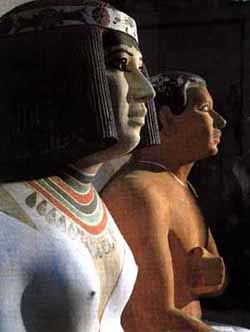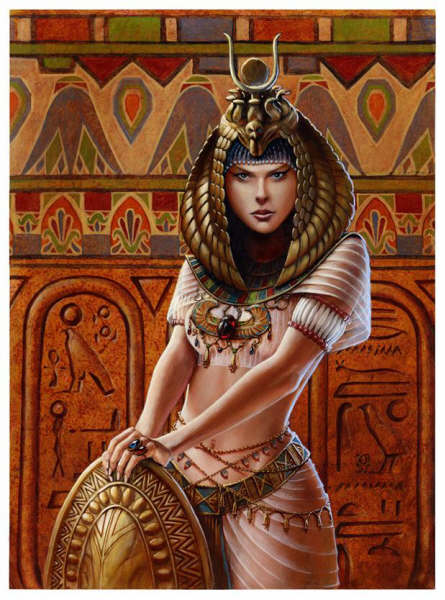The Events Surrounding the Decline of the Matriarchal Society in Egypt 
To understand a society, we must look at the myths and the religions produced by that society. By examining the changes wrought upon a society's myths throughout its history, we can come to a greater understanding of what life must have been like on a daily basis in that society.
Thus, when we examine the Neolithic Period of Egyptian religion and mythology, and trace the changes that occur in that mythology as the years pass, we can see a pattern emerge portraying a slow shift in the balance of power from women to men.
The matriarchal period of Egypt appears to have extended from prehistoric time up until the first appearance of Osiris c. 3000 BC. This gradual introduction of a male deity into a society parallels the slow colonization of Egypt by foreigners from the north. However, the paradigm shift from a matriarchal to a patriarchal society does not completely overtake Egypt until the very beginning of the New Kingdom, c. 1570 BC.
Throughout all areas of the near and middle east during the Neolithic period there appeared to have been a widespread Goddess cult, based on the recovery of the so-called Venus figurines from widely scattered archeological sites. The similarity of style in these figurines suggests that a similarity of worship and rituals could also have existed. This Goddess cult could very well have been the origin of all matriarchal societies, especially those of an agricultural bias, such as Egypt and its neighbors to the northeast in the Mesopotamia.
The clans of Egypt were matri-lineal, in that the mother was seen as the primary parent of her family, perhaps due to a lack of knowledge regarding the processes of conception. If this were so, the act of gestation and of giving birth must have seemed a magical act. Thus it was that family lineage was traced through the female gender, going from mother to daughter instead of from father to son. After countless generations of this type of culture, it is easy to understand how the oldest ancestors of any given clan could have first been revered, then deified, and finally mythologized into becoming a proto-goddess.

If this were the case, it would help explain the similarities and the differences in Goddess worship throughout prehistoric Egypt. Prior to c. 3000 BC, Egypt was divided into Upper Egypt, where the Goddess was known as Nekhebt, and Lower Egypt, where the Goddess was known as Ua Zit. Nekhebt was personified in the form of a vulture, while Ua Zit was personified as a cobra. In fact, the vigil of a cobra eventually came to symbolize the word Goddess in hieroglyphic writings.
Then, c. 3000 BC, there is evidence of an invasion of Egypt by people from Mesopotamia. These people brought with them the concept of kingship, as well as the technology of brick building and writing, as well as the introduction of Mesopotamian motifs into Egyptian artwork. They also brought the concepts of a male deity.
Up until this invasion, Ua Zit and Nekhebt were the supreme deities in Egypt, but after the establishment of a kingship, and the unification of Upper and Lower Egypt under one king, Ua Zit and Nekhebt were demoted. Interestingly enough, as this first introduction of a male pantheon was underway, there was the formation of a religion based around the Lady of the Serpents on the isle of Crete. This seems to indicate that refugees had fled the formation of the First Dynasty of Egypt, bringing with them the worship of their Goddess.
Ua Zit is also known as Hathor, who was the primal serpent believed to exist at the beginning of time, and who made the heaven, the earth, and all life. Hathor also threatened to destroy all of creation and return to Her primal state as a serpent behind all things. This legend of creation seems to be another form of the legend of Tiamet, from nearby Mesopotamia, which also indicates the cultural influences of this time in Egypt.
It is during this period of religious and social upheaval that a great deal of changes in the pantheon of the Egyptians takes place. Pictures from this time show the sun God Hor-Wer riding in his boat of the heavens. This deity is also known as Shu, or Lord Air. Through examination of the hieroglyphs, we see that the sign for air is a sail, and the sign for the word God is a series of banners or pendants, such as those seen at the prow of boats. Therefore, this first male deity can be seen to be arriving in Egypt as a part of an invasion force, rather than an indigenous deity arising from amidst the population. Even as the glyph for Goddess is rooted in the concept of the serpent, as the cobra, so too the glyph for God rooted in the concept of war banners.

 Free Forum Hosting
Free Forum Hosting